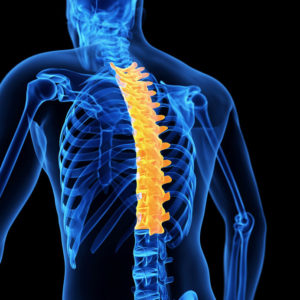 Thoracic THURSDAY!! It’s Thursday so why not talk about the Thoracic spine?!?!
Thoracic THURSDAY!! It’s Thursday so why not talk about the Thoracic spine?!?!
Your thoracic spine (mid-back) is the longest region of your spine, made of twelve different vertebrae that span from just below the base of the neck (cervical) to the stomach region (lumbar). This section of the spine plays a crucial role in overall function of the body, not only protecting a large portion of the spinal cord but also anchoring down the ribs so they can protect the heart and lungs.
When Your Thoracic Spine is Misaligned
It takes very little to push one of your spinal vertebrae out of alignment, whether it’s a physical accident, stress/tension in the body or simply hunched over at your desk working at the computer. It’s part of life! That, however, means that you’re vulnerable to a misalignment, known as a subluxation. While a healthy vertebra with no misalignments protects the spinal cord, a subluxated vertebra can put pressure on the spinal nerves, disrupting the messages that are supposed to flow from the brain to other organs in the body. This, in turn, can affect the function of various areas of the body—some you may not even expect!
Take a look at each vertebra and how it connects with different organs and areas in the body. And most importantly, identify any possible symptoms that could arise from a subluxation in that vertebra!
Vertebrae ; Parts of the Body ; Possible Symptoms
T1 Arms from the elbows down, including hands, Asthma, cough, difficulty breathing
wrists and fingers, esophagus and trachea shortness of breath and pain in the lower arms
or hands
T2 Heart, including its valves, covering Functional heart conditions and chest
and coronary arteries conditions
T3 Lungs, bronchial tubes, pleura, Bronchitis, pleurisy, pneumonia,
chest and breast congestion and influenza
T4 Gallbladder and common duct Gallbladder conditions, jaundice and shingles
T5 Liver, solar plexus and general circulation Liver conditions, fevers, blood pressure
problems, poor circulation and arthritis
T6 Stomach Stomach troubles, including nervous stomach,
indigestion, heartburn and dyspepsia
T7 Pancreas and duodenum Ulcers and gastritis
T8 Spleen Lowered resistance
T9 Adrenal and suprarenal glands Allergies and hives
T10 Kidneys Kidney troubles, hardening of the arteries,
chronic tiredness, nephritis and pyelitis
T11 Kidneys, ureters Skin conditions such as acne, eczema and boils
T12 Small intestines and lymph circulation Rheumatism, gas pains and certain types of
sterility



Leave A Comment
You must be logged in to post a comment.